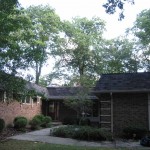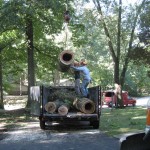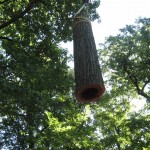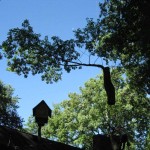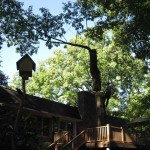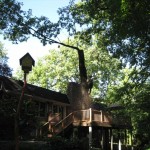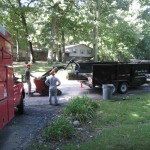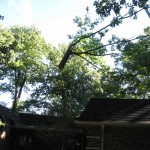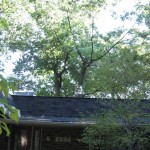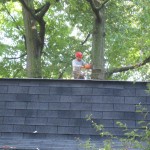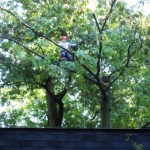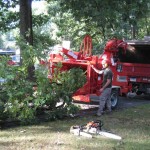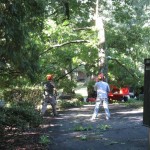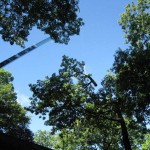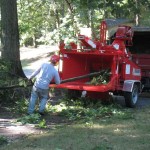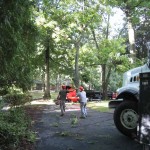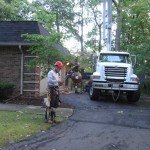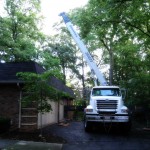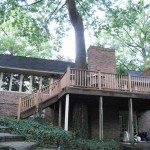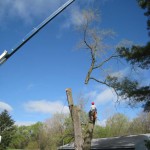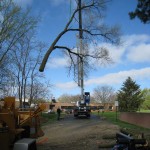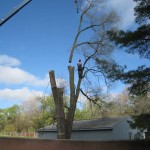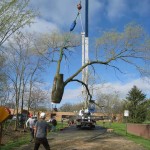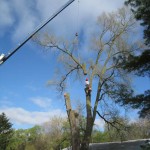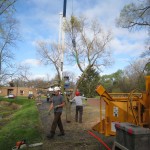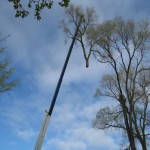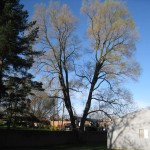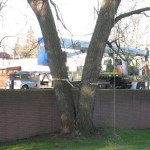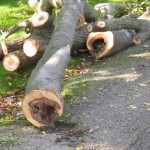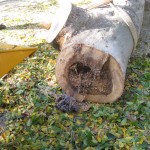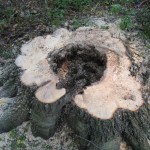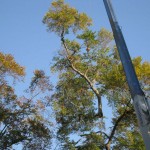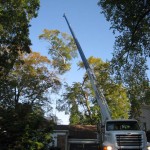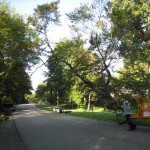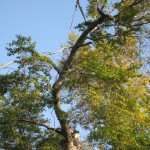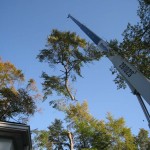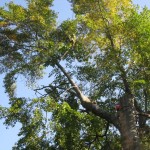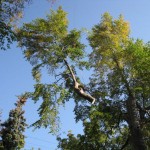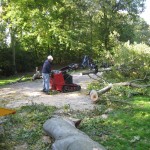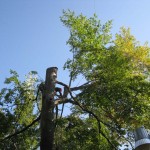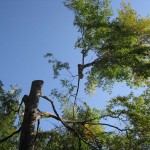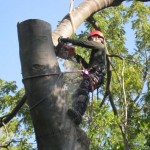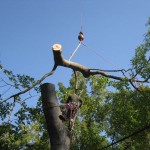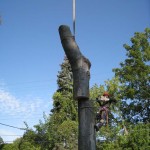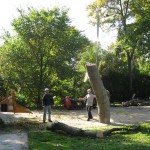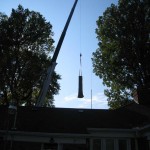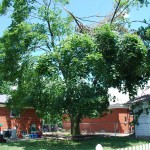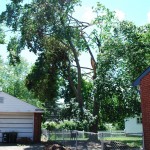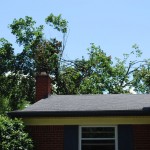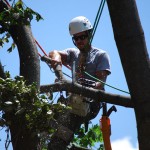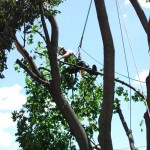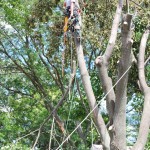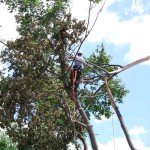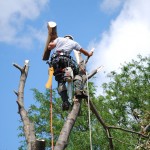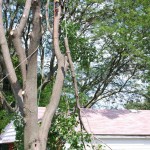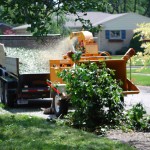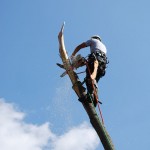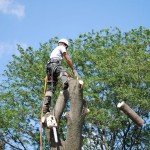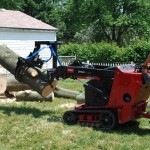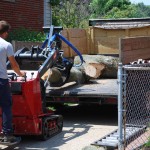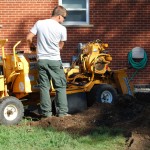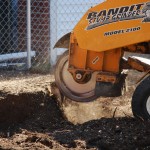Tree Removal – Northville, Michigan
We were contracted to remove this massive cottonwood tree in Northville, MI. The tree was in the back yard, down a hill, next to a pool, over the house and garage. It would have been nightmare to remove this tree conventionally. Our removal plan involved working with a 28ton crane. The crane was used to lift sections of the tree up and out of the backyard, setting them down in the driveway to be processed. Our team worked flawlessly to remove this massive tree in just a matter of hours. This is why our customers our so happy with our work. By working efficiently, not cutting corners, we were able to complete this removal in a cost effective manner.
Below is a time-lapse video of this crane assisted tree removal.
Video available in HD, please change YouTube video quality setting.
Precision Tree Removal – Bloomfield Hills, MI
This home in Bloomfield Hills was recently purchased by a client. They were concerned about a large red oak tree behind the house. The previous owner had build a deck around the tree. Upon inspection, I discovered a hollow at the base of the tree. This hollow was probably the result of construction damage many years ago. I recommended immediate removal for several reasons:
- The hollow at the base of the tree was filled with brick and mortar – this is an outdated technique that does not stop decay. It also prevented me from seeing the full extent of the hollow during inspection.
- The tree had heavy lean towards the house – seeking more sunlight, the tree was rapidly growing out over the house to soak up the sun.
- The proximity to the home and deck – if this tree were to fail at any point, it would come down hard directly onto the house.
All of these factors made the decision to remove the tree a no-brainer. With the assistance of a 28-ton crane, we were able to remove this tree with extreme precision. Its location would have made it very challenging for an inexperienced or ill-equipped crew.
Below are pictures that show the tree removal process, click a thumbnail to view a slideshow.
Summer Time “Sudden Limb Drop” American Elm Tree – Livonia, MI
In the June of 2012, this elm tree had a large branch drop on a local school. Luckily school was out for the summer and nobody was around when it happened. The limb did not completely detach from the tree, it came to rest on the roof and hung up in another limb below it. This saved the building from any major damage.
When I first arrived on the scene, I was asked why such a big limb would break on a perfectly calm day? My answer is known to arborists as “sudden limb drop”. This usually occurs on hot summer days in periods of drought, just like the conditions we saw in June. The tree is losing large amounts of water through transpiration, which is like sweating for trees. Sudden limb drop occurs when a limb dries out quickly, becomes brittle, and then can no longer support itself.
The next issue was whether or not to remove the whole tree. While it looked healthy from the street, there was actually a large dead section in back over the school. Upon inspection it was obvious the tree had contracted Dutch Elm Disease. It was then we decided the tree must come down. The tree was removed over the course of 7 hours with the assistance of a 28-ton crane. We hauled away 15 yards of wood chips from brush chipping and over 30,000 lbs of logs. When we were done it was like the tree was never there.
Why hire us?
- Precision – Much of the tree was over the school, stretching out over the roof 40 feet or more. There was also utility lines and a sidewalk to avoid. With the help of the crane there wasn’t even a dent in the lawn.
- Efficiency – The tree was taken down, hauled away and the stump ground in 7 hours. A less equipped service would have struggled with a tree of this size, taking extra days to handle the large logs and grind the stump.
- Economical – Large hazardous trees are often underbid by ill-equipped and inexperienced services, while larger companies can overbid due to difficulty and taking too long on the job. We usually aren’t the highest or the lowest, we charge a fair price for quality work.
The time lapse video below shows the removal process from, 7 hours to 7 minutes.
Split Siberian Elm Tree Removal – Famington Hills, MI
I was called to look at this siberian elm after the homeowner noticed a large split at the base of the tree. In this case, the split was severe and warranted removal of the tree as soon as possible. The homeowner attached a come-along at the base while I installed a dynamic cable in the canopy to help hold the tree together. We returned with Robin of Affordable Crane Service to dismantle the tree in the morning.
I proposed to remove this tree with the assistance of a crane for several reasons:
- Safety – The tree had a severe split at the base. Rigging the tree down conventionally off itself would put extra stress on this split, putting the climber and property at risk.
- Efficiency – With the help of the crane the tree was removed and cleaned up in 5 hours. Removing this tree conventionally would have taken much longer and cost the homeowner more money.
In conclusion, this tree removal was made more safe, efficient, and cost effective by utilizing the crane. The homeowner chose us to remove the tree because in his words “you had a plan and shared it with me at the time of the estimate. The other guy didn’t say how he would remove the tree and he quoted a higher price.”
Below are pictures and a video of the removal process, click a thumbnail to view a slideshow.
Crane Assisted Beech Tree Removal – Livonia, MI
I was called to inspect this beech tree on a property in Livonia, MI. Upon inspection, I discovered a cavity at the base of the trunk, several rotten branch unions in the upper canopy, and a hollow mid-trunk. The tree leaned heavily toward the house, and with three known weak spots, I made a recommendation to remove the tree.
- Safety – The tree had multiple weak spots. Rigging the tree down conventionally off itself would put extra stress on the weak spots, putting the climber and property at risk.
- Low Impact – There wasn’t direct access to the back yard. The only way out of the back yard was down steps and up a hill through the neighbor’s landscape. Hauling the tree out this way would have caused lawn and landscape damage to the homeowner’s and neighbor’s property.
- Efficiency – With the help of the crane the tree was removed and cleaned up in 5 hours. Removing this tree conventionally would have taken much longer and cost the homeowner more money.
In conclusion this tree removal was made more safe, efficient, cost effective, and had less impact on the surrounding landscape by utilizing the crane.
Crane Assisted Oak Tree Removal – West Bloomfield, MI
This oak tree sat behind a garage in West Bloomfield, MI. It had been improperly pruned in the past. The interior and lower branches of the tree had been stripped, creating a lions-tail effect.
Some negative effects of lion’s tailing are:
- Too much foliage is removed, compromising the health of the tree
- Uneven weight distribution, leaves too much weight at the branch tips
- Exposes the inner portion of the tree to sun-scald
- Triggers fast growing watersprouts, wasting the tree’s energy
- The tree may become hazardous as the branches become weak and break
Access to this tree was very limited. The area under and around tree was thick with underbrush and saplings. The house and garage were built into a hillside, blocking any direct route to the tree. We were able to preserve the natural area under the tree by removing it with a crane.
This time lapse video was shot to help our customers better understand the crane removal process.
Storm Damaged Norway Maple – Plymouth, MI
High winds and heavy rain blew through Plymouth, MI in early June 2010. The Norway maple, shown below, was heavily damaged during the storm. Most of the upper crown was broken apart and hung up in a twisted mess. Below, another large limb tore off and created a large wound in the trunk.
The homeowners wanted to know if the tree could be saved. It had provided the patio and back of the house with ample shade for many years. I advised them to remove the tree for the following reasons.
There was a large wound in the trunk where a lower limb had torn out. When the limb broke it pulled out of the trunk creating a cavity. Over time the exposed heartwood will rot and weaken the tree creating a hazard.
Just removing the broken limbs would leave the tree lop sided and unsightly. Some of our competition might offer to “shape or top” the tree in this situation. I advised against this due to the long term affects of topping. A topped tree will either die or shoot out sprouts around the topping cuts. Around each cut multiple sprouts will grow. Over time the sprouts get bigger and the wound where the topping cut was made gets weaker, creating a hazard. Eventually, one or more of the sprouts will break off. You end up paying to remove a tree that you already payed to top. For a more in-depth explanation on why not to top your trees, click here
-Evan

